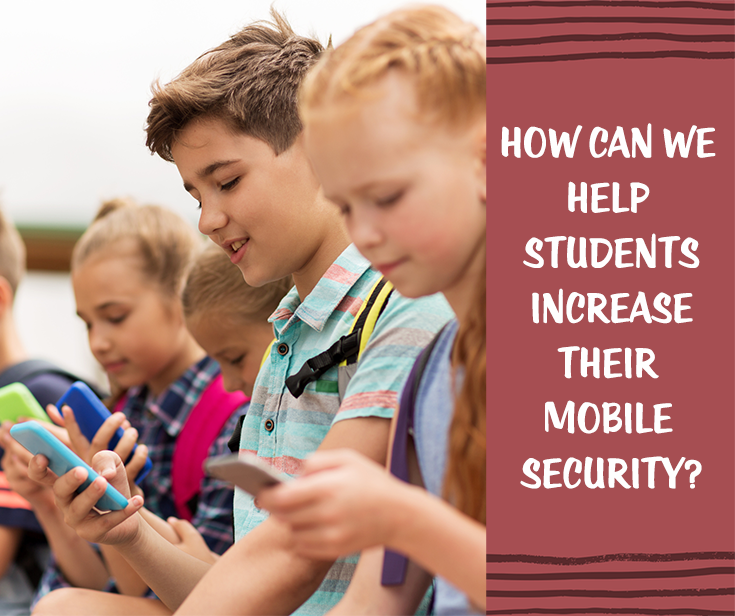Boosting Mobile Security: Safety Tips for Students
Posted by Network Support · Leave a Comment
Boosting Mobile Security: Safety Tips for Students
Smartphones are an integral part of students’ lives. At this juncture, the question needs to be asked – how safe are they? Mobile security is certainly a cause for concern, especially considering the presence of rampant digital threats. It’s important that students understand and apply any built-in security and privacy features. To help ensure student safety and to boost their mobile security, we have listed some important tips and techniques which they can follow:
- Storing Data: Students can be reminded to follow a very simple rule for storing data- “if it’s not something they want others to see, then it’s best not to store it on the phone.” This includes photos, videos and chat messages that might later compromise the student’s safety and privacy.
- Keep Stored Data Safe: This can be done by encrypting the stored data or by activating the remote wipe function. In case of a theft or loss, students can then remotely delete all their data and prevent it from being compromised. Some phones also allow for automatic deletion of data when the wrong passcode is entered a set number of times.
- Visible Emergency Contacts: Make emergency contacts visible at the pin entry screen. In cases of emergencies, individuals may try unlocking the phone to access contacts. Placing this information where it’s easily viewed deters others from unlocking the phone and accessing other data.
- Be Suspicious: Instruct students to be suspicious and wary of texts and emails received from unfamiliar sources. It helps to decrease the vulnerability to phishing attacks. Also remind them to always access sites that are secure (look for the lock icon present in the browser’s address), and check for authenticity of applications before downloading or buying them.
- Accessing Public Wifi: Remember that not all public Wi-Fi hotspots are secure. Always activate your security settings when accessing public Wi-Fi hotspots and remember not to share private and personal information. Recommend the use of Virtual Private Networks (VPN) and HTTPS web connections when connecting on an open Wifi.
- Disable Location Settings: Stress the importance of disabling location settings in phone and different apps. While it is fun for students to share their location with friends and others, emphasize that the same information can compromise the student’s safety, if made known to other unfriendly individuals.
Mobile Contracts: Collaborate with the students and create a mobile contract which students should adhere to. This contains a list of rules and responsibilities which the students agree to follow, encouraging the safe use of their phones. A sample of this contract can be found Passcode Lock: Instruct students to choose passcode locks that are complex (9 digit or alphanumeric in nature) and not easily decoded. Remind them not to use birthdays, street numbers and house numbers as the passcode or to share this code with others. Encourage them to use patterns and fingerprints as the unlocking code as it increases mobile security.
Mobile Safety Contract Sample
This is a sample of a Mobile Safety Contract that you can form for your students. Create this in collaboration with your class to encourage more adherence to it. Once created and signed, a copy of the contract can be handed over to the parents, to keep them abreast of the safety procedures that you have taught the child.
I, ………….. (name of student) pledge that I will:
- Be careful and selective about those to whom I reveal my phone number and personal information.
- Not reveal my mobile passwords and passcodes to anyone other than my parents/guardians.
- Not store any compromising data (pictures, videos, information, passwords) about myself or others that can be used to harm or threaten safety and privacy.
- Immediately inform my parents/guardians or teachers in case of a theft or loss of my phone.
- Activate all the security settings available in my phone and to disable my location tracking settings in apps that might otherwise compromise my safety.
- Not open myself up to unwanted attacks by opening emails or texts from unknown sources, or by accessing sites that are unsafe or not age appropriate for me.
- Be careful when accessing public WiFi hotspots and refrain from sharing personal information when using them.
- Not buy or download any applications from third party sources.
I understand that these rules help to keep me safe and agree to follow them, failure of which can result in:
- ………
Signature of student. Teacher
Although there are no guaranteed methods by which one can completely insure their mobile security, the above tips go a long way in increasing students’ safety and privacy. Create a safe and positive classroom environment for students that encourages them to discuss safety with teachers and seek help.
Like this article for teachers?
Browse the Professional Learning Board COURSE CATALOG to find related online courses for teachers in your state. Professional Learning Board is a leading provider of online professional development classes that teachers use to renew a teaching license or renew a teaching certificate.





